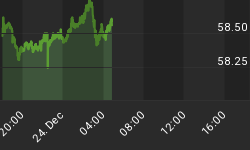... will break your bones, but charts will never hurt you.
We are living in "fundamental" times, Ladies and Gentlemen. Momentous events and powerful secular trends rule our economy, currency, and political landscape. The world is in the middle of an upheaval the likes of which it hasn't seen in decades, and few appreciate its impact so far. Who needs "WWIII" when we live in such chaos already?
Whether we are now in the middle of another world war or not - we might as well be, for the changes we are undergoing are just as gargantuan as those that changed world maps after WWII.
In the face of such changes, charts are about as useful as predictive devices as a rearview mirror on a speed train.
Investor sentiment and cycles are great forecasting tools - in normal times.
But when the earth shifts under your feet and a crack starts opening up right between your legs, you don't rely on past data concerning soil consistency, or try to calculate how far you can spread your legs to straddle the divide without falling into it. You get the heck out of the way.
When every single economic parameter continues to out-flap the unflappable, when age-old relationships among those parameters are turned on their head, you don't want to build your investment strategy on the sands of charts and technical analysis.
You want bed-rock fundamentals - and you run with them, no matter what the charts say.
Recently we heard a lot of advice from the TA camp warning that it's dangerous to stay on the same side of a trade as everybody else, hinting that the dollar will get a serious bounce very, very soon because there are just too many traders and investors piling in on the short side of the dollar, and therefore on the long side of gold.
Last week we did see quite a bounce in the dollar - but that's probably about all we will see anytime soon. The dollar has already lost steam on this Monday, December 13, 2004.
A good rule to keep in mind is this:
Fundamentals can break the most beautiful charts -- but charts will NEVER break fundamentals.
(I do use charts as you can see below, but only to illustrate, never to predict).
The fundamentals are simple: the US wants a lower dollar, needs a lower dollar, must have a lower dollar, so expect no help from this side of the Atlantic when it comes to supporting it.
The current account deficit is on everyone's mind. It won't go away just because consumer confidence returns or because Christmas sales are pointing up. It is here to stay and, as a smart and observant financial news commentator has noted (I believe it was from the Financial Times), the current account deficit has continued to go up at a breakneck rate since the dollar peaked in early 2002. According to conventional analysis, it should have fallen along with the swooning dollar.
But it hasn't.
Just take a look at this chart:

Not exactly a comforting picture, is it?
If it's so clear that a falling dollar will not reduce the Trade deficit, then why is the US so hell-bent on dropping the dollar? The answer may lie in the fact that the Dow, after all, is in fact up from pre-November days, and that the plan may in fact be to undercut the euro to the point of no-return.
Another question worth asking is this: If the US plan really is to reduce the deficit, and if so far the deficit hasn't budged, then how far does the dollar have to fall before it will cause the deficit to shrink?
That's a frightening thought, is it not? Look how far the dollar has already fallen without showing even a hint of the desired result. Then consider how far it still has to go before the deficit will reverse course. And, finally, think how much further the dollar must fall to actually bring the deficit down to more manageable levels??
There is no way of telling how far, except that you can say this with a great amount of confidence: if reducing the deficit is the goal, the dollar has to fall VERY FAR, indeed to have any real effect!
Makes you wonder whose comfort zone will be invaded first by such a falling dollar: that of the euro-zone, or that of the United States?
The US needs a strong Dow - if only for symbolism's sake. And a stronger Dow is what the US got, especially post-election.

As predicted, this Dow-jump occurred exactly during the time of the worst dollar-slump, right on cue and true to form according to the upside-down, intuitively illogical pattern that has developed since 2003.
This is going so far as to even bring the Dow near its break-out point from the downtrend it established since December 1999:

And that during a time of rising inflation, gold, and interest rates. Go figure!
It may be stupid or at least reckless to run the dollar into the ground that way, but apparently it gives the regime enough leeway to create another phony Dow-boomlet. One thing is certain: when the Dow finally goes south below the 7000 mark, the Dow being the last symbol of US economic might that people can hold on to, then the entire package will go south.
Then, foreigners will seriously start withdrawing their investment funds.
Then, Asians will seriously stop buying US debt paper.
Then, the 20-plus year party will be over, and the guests will go home.
Then, long-term interest will go ballooning and household debt will choke off the Atlas-like, pathetically heroic US consumer.
An then, watch gold move!
I hope you'll have sunglasses and a telescope ready nearby when that happens.
Is gold overbought, technically speaking?
Maybe so ... but you know what panicky crowds are capable of - especially when pushed by overwhelming fundamentals.
Got gold?















